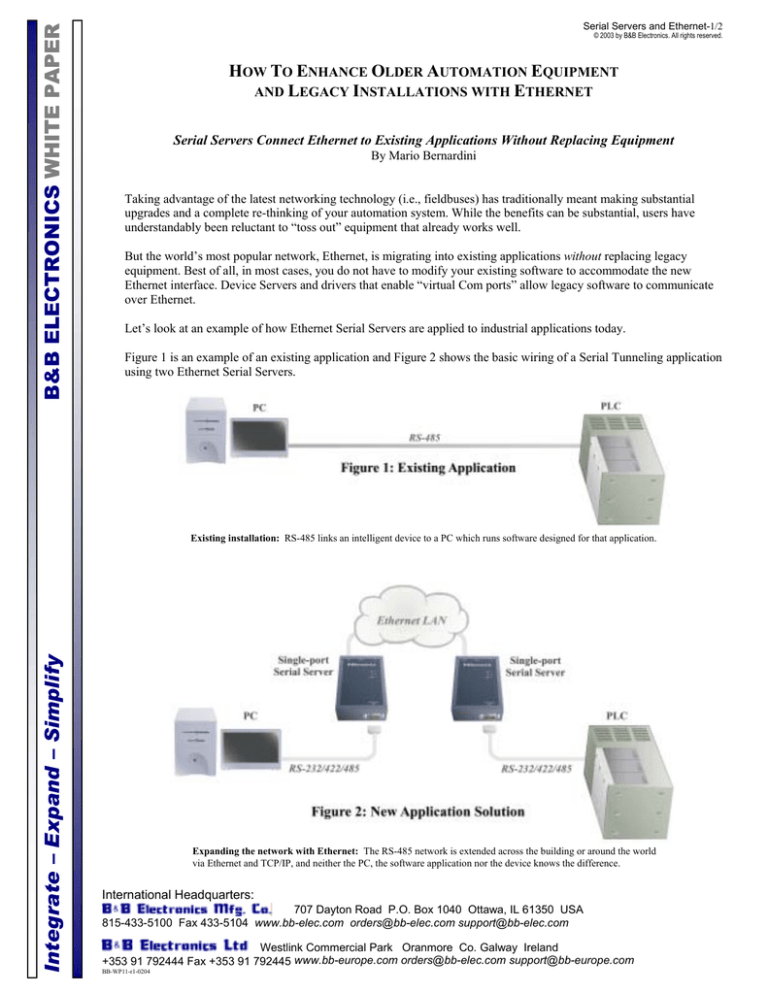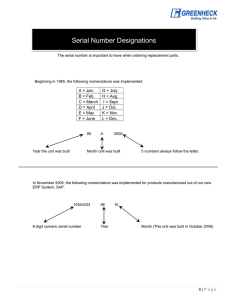
B&B ELECTRONICS WHITE PAPER
Serial Servers and Ethernet-1/2
© 2003 by B&B Electronics. All rights reserved.
HOW TO ENHANCE OLDER AUTOMATION EQUIPMENT
AND LEGACY INSTALLATIONS WITH ETHERNET
Serial Servers Connect Ethernet to Existing Applications Without Replacing Equipment
By Mario Bernardini
Taking advantage of the latest networking technology (i.e., fieldbuses) has traditionally meant making substantial
upgrades and a complete re-thinking of your automation system. While the benefits can be substantial, users have
understandably been reluctant to “toss out” equipment that already works well.
But the world’s most popular network, Ethernet, is migrating into existing applications without replacing legacy
equipment. Best of all, in most cases, you do not have to modify your existing software to accommodate the new
Ethernet interface. Device Servers and drivers that enable “virtual Com ports” allow legacy software to communicate
over Ethernet.
Let’s look at an example of how Ethernet Serial Servers are applied to industrial applications today.
Figure 1 is an example of an existing application and Figure 2 shows the basic wiring of a Serial Tunneling application
using two Ethernet Serial Servers.
Integrate – Expand – Simplify
Existing installation: RS-485 links an intelligent device to a PC which runs software designed for that application.
Expanding the network with Ethernet: The RS-485 network is extended across the building or around the world
via Ethernet and TCP/IP, and neither the PC, the software application nor the device knows the difference.
International Headquarters:
707 Dayton Road P.O. Box 1040 Ottawa, IL 61350 USA
815-433-5100 Fax 433-5104 www.bb-elec.com orders@bb-elec.com support@bb-elec.com
Westlink Commercial Park Oranmore Co. Galway Ireland
+353 91 792444 Fax +353 91 792445 www.bb-europe.com orders@bb-elec.com support@bb-europe.com
BB-WP11-r1-0204
B&B ELECTRONICS WHITE PAPER
Serial Servers and Ethernet-2/2
© 2003 by B&B Electronics. All rights reserved.
Serial tunneling is one of the many available ways Ethernet Serial Servers are designed to allow access by serial
devices to a LAN.
There are a couple reasons why you might choose to use Serial Tunneling to solve your application needs. First, if the
application is using a legacy DOS program to control a serial device; and second, if the application is not using a
computer at all. Some applications will have two serial devices talking to each other. A DOS program, in most cases,
will open a standard onboard port, Com 1, 2, 3, or 4. In this case Port Redirect software will not be an option.
To communicate using the Tunneling feature, each Serial Server is configured with a unique IP address and the
address of the remote unit. This is configured in the Serial Servers menu. The menus are normally accessible by a
terminal program, Web page or TELNET. The network administrator will normally provide the needed network
addresses. Most serial servers will have a management system that allows an automatic connection to be established
between the two devices once they are connected to the LAN and configured and power is applied. This connection
process simply means that one serial server is able to find the other serial server anywhere on the LAN.
This is a simplistic look at IP addressing. Just as a person is able to receive mail by their mailing address, the IP
address of a device identifies it on a LAN that may have hundreds of devices, each having a unique IP address. A
transmitted Ethernet frame has to negotiate its way through the LAN to the destination device, which will take it
through routers, switches and/or hubs. The destination IP and MAC address is an important part of the Ethernet frame.
LAN switches and routers will read the Ethernet frame and route the frame in the correct direction. The routing of a
frame in the correct direction has a desirable result, namely, less traffic on the LAN. The routing of Ethernet frames is
a result of the IP address and MAC address of the devices. The manufacturer assigns a MAC address to every Ethernet
device. (We will go into detail on this in another issue.)
Once a connection is established between the two serial servers, the LAN becomes transparent to the PC and factory
device, or two unintelligent devices that need to communicate. Since the LAN is transparent to the serial devices, the
PC will use the same software as in the RS-485 application and the factory device will not have to be reconfigured.
Serial devices that were once limited to a serial connection can be network-enabled with the Ethernet serial servers
that are now available. Now in industrial, retail, or building applications where a LAN connection exists, a serial
device can be connected and become part of a centralized Ethernet communication system. Imagine the extensions of
the LAN allowing devices access to any other device or PC on the LAN without dedicated wires.
Integrate – Expand – Simplify
The next article in our Ethernet series will cover how Redirect Software is being used to communicate with Ethernet
Serial Servers. To receive a copy, or if you have any questions or comments regarding the application of Serial
Servers, please contact me by e-mail at mbernardini@bb-elec.com.
International Headquarters:
707 Dayton Road P.O. Box 1040 Ottawa, IL 61350 USA
815-433-5100 Fax 433-5104 www.bb-elec.com orders@bb-elec.com support@bb-elec.com
Westlink Commercial Park Oranmore Co. Galway Ireland
+353 91 792444 Fax +353 91 792445 www.bb-europe.com orders@bb-elec.com support@bb-europe.com
BB-WP11-r1-0204






